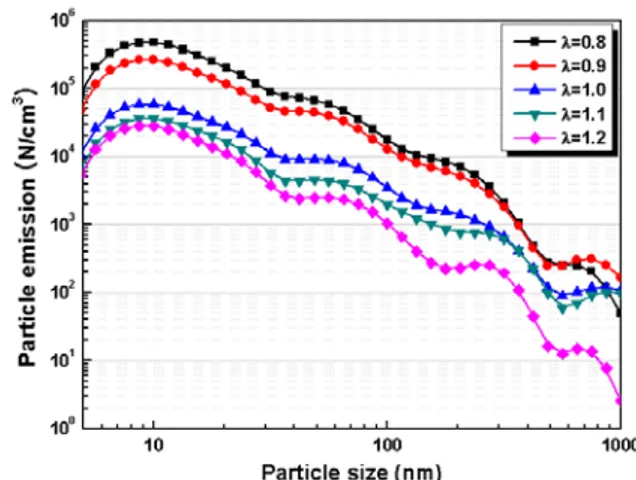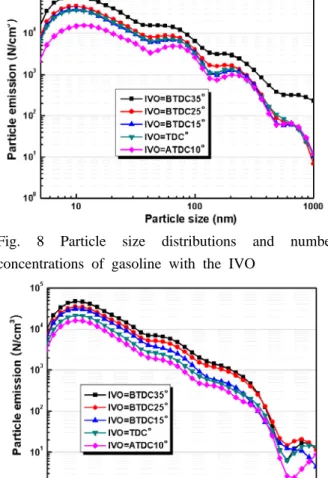가솔린과 바이오 에탄올 혼합 연료의 엔진 및 차량 모드
주행시의 입자상 물질 배출 특성
고아현
†․
이형민
*․
최관희
*․
박심수
**․
이영재
***Particle emission characteristics of gasoline and bio ethanol blend
in the engine and vehicle mode test
Ahyun Ko, Hyungmin Lee, Kwanhee Choi, Simsoo Park and Young Jae Lee
Key Words: PM(입자상 물질), Bioethanol(바이오에탄올), DMS500(고속 입자상 물질 분석기), FTP-75(공인연비인증모드)
Abstract
This paper was focused on the particulate matter (PM) on the gasoline and bio ethanol. Bio ethanol as a clean fuel is considered one of the alternative fuels that decreased the PM emission from the vehicle. Particle formation in SI engine was depended on the fuel and engine operating condition. In this paper, Particle number concentration behaviors were analyzed by DMS500 (Differential Mobility Spectrometer) and CPC (Condensation Particle Counter) instrument which was recommended by PMP (Particle Measurement Programme). Particle emissions were measured with various engine operating variables such as air excess ratio (λ), spark timing and intake valve opening (IVO) at part load condition. In vehicle test, the number of particulate matter was analyzed with golden particle measurement system, which was consist of CVS (Constant Volume Sampler), particle number counter and particle number diluter.
†
고아현, 고려대학교 대학원 기계공학과 E-mail : hydra32@korea.ac.kr TEL : (02)3290-3869 FAX : (02)926-9290*
고려대학교 대학원 기계공학과**
고려대학교 기계공학부***
한국에너지기술연구원1. 서 론
자동차 배기가스가 환경 및 인체에 끼치는 영 향에 대한 연구가 지속적으로 발표됨에 따라 세 계 각국은 배기가스에 대한 규제를 점차 강화하 고, 이에 따라 자동차 제작사에서도 배기가스를 줄이기 위한 연구를 지속하고 있다. 특히 눈에 보이지 않는 나노미터 크기의 입자상 물질은 크 기가 큰 입자에 비하여 호흡기의 점막에 의하여 걸러지지 않고 최종 폐포까지 들어가기 때문에 인체에 더욱 치명적이다(1) . 현재, 자동차 배기가 스의 입자상 물질은 중량측정을 통하여 규제하고 있다. 그러나 중량측정법은 큰 입자를 규제하는 방법에는 유리하지만 미세입자크기의 입자상 물 질은 측정필터를 통과하기 때문에 적합하지 않 다. 따라서 인체위해성 측면이 지속적으로 제기 됨에 따라 국제 PMP 는 현재의 중량규제법을 보 완하기 위하여 유럽, 일본, 한국 등 참여국들과 Light-duty ILCE (Inter Laboratory Correlation Exercise)를 시행하여 수량 규제법 마련을 위하여노력하고 있다(2)
. 입자상 물질 연구는 주로 디젤 및 GDI (Gasoline Direct Injection) 엔진에 한정되
어 왔다(3) . 연구결과에 따르면, 가솔린 차량의 입 자상 물질 개수 농도는 디젤에 비하여 낮으나, 도시 지역의 가솔린 차량수가 디젤에 비하여 월 등히 많기 때문에, 가솔린 차량에서 배출되는 입 자상 물질은 중량 기준으로 68%, 수량 기준으로 대한기계학회 2008년도 추계학술대회 논문집
Property items E0 E10 RON 93.2 95.6 Air/Fuel Ratio (Stoichiometric) 14.59 14.03 Distillation Temp. (℃) 10 vol(%) 51.9 50.6 50 vol(%) 80.0 66.5 90 vol(%) 153.9 149.9 End point 192.3 190.2 Benzene (vol%) 0.43 0.40 Olefin (vol%) 14.6 12.6 Sulphur content (mg/kg) 18.00 11.45
Total aromatics (vol%) 18.57 17.70
Oxygen (weight%) 1.75 5.70 90%를 차지한다고 보고되었다(4). 석유 에너지 가 격의 폭등으로 세계 자동차 제작사들은 친환경 연료를 이용한 차량개발에 박차를 가하고 있다. 그러나 청정연료를 사용하는 엔진에서도 나노크 기의 입자상 물질이 배출된다는 보고에 따라 입 자상 물질 저감을 위한 연구가 활발해지고 있다. 따라서 본 연구는 가솔린과 바이오 에탄올 연료 를 사용하여 각 연료의 엔진 운전 조건에 따른 시험과 실제 도로주행을 모사한 차량시험을 통하 여 입자상 물질의 입경분포 및 개수농도 배출 특 성을 확인하였다.
2. 실험 장치
2.1 엔진 실험 장치 Fig.1 은 가솔린엔진에서 입자상 물질의 배출특 성을 분석하기 위한 장치구성도이다. 장치 구성 은 입자상 물질 분석장비인 DMS500과 엔진, EMS 등으로 구성되어 있다. 엔진은 2000cc급 CVVT (Continuously Variable Valve Timing) 엔진 으로 제원은 Table 1에 나타내었다. 연료는 가솔 린 90%와 바이오 에탄올 10%를 혼합한 E10과 가솔린 100% 두 가지 연료를 이용하여 실험하였 으며, 자세한 연료 성상은 Table 2에 나타내었다. ECU Crank Position Sensor Knock Sensor Coolant Sensor O2Sensor Fuel Injector Camshaft Position Sensor Throttle body SensorMAFFuel Supply System ECU Controller WCC Exhaust muffler Fast Response PM Analyzer Spark Plug with pressure sensor Amplifier ECU ECU Crank Position Sensor Knock Sensor Coolant Sensor O2Sensor Fuel Injector Camshaft Position Sensor Throttle body SensorMAF
Fuel Supply System ECU Controller WCC Exhaust muffler Exhaust muffler Fast Response PM Analyzer Fast Response PM Analyzer Spark Plug with pressure sensor Amplifier
Fig. 1 Schematic diagram of experimental system Table 1 Specifications of test engine
Engine type In line, DOHC 16V
Displacement 1,998 cc
Compression ratio 10.5 : 1
Valve timing IVO IVC EVO EVC
11°/34° 67°/22° 34° 10° Emission control WCC Fig. 2는 DMS500의 원리를 보여주고 있다. DMS500은 5nm ~ 1000nm 크기의 입자상물질의 개수뿐만 아니라 크기별 분포까지 최고 100ms 속 도로 분석할 수 있는 장비이다. DMS500에서 채 취된 배기가스의 입자상물질은 강한 전하로 대전 되어 그것의 전하량과 항력에 관한 함수로써 분 석되게 된다(5) .
Table 2 Specifications of fuels
Fig. 2 Schematic of DMS500 fast particulate spectrometer ` Exhaust Gas Analyzer Standard Gas Air HEPA Filter Fan Chassis Dynamometer Driver Aid Controller Dilution Tunnel Particulates Filter Holders
Mass flow controller sampling probe Blower CPC Vacuum Pump cyclone PND1 Heated Tube evaporates volatiles PND2 DMS500 Controller Sample heated line
Fig. 3 Schematic diagram of vehicle experimental system
2.2 차량 실험 장치
Fig. 3은 차량 실험 구성장치로써, PMP에서 권고하는 GPMS (Golden Particle Measurement System) 사양과 동일한 측정시스템으로 이루어져 있다. DMS500은 차량의 배기구에 설치되어 실시 간으로 입자상 물질을 측정하였다. 시험에 사용 된 모드는 공인연비인증시험 모드인 FTP-75 mode를 주행하여 시험하였다. 시험차량의 자세한 제원은 Table 3 에 나타내었다.
Table 3 Specifications of test vehicle
Engine type In-line, DOHC
Displacement 1,599 cc
Compression ratio 10.0 : 1
Weight empty (kg) 1,170
Transmission type AT4
Emission control MCC
3. 입자상 물질 배출 특성
3.1 엔진 입자상 물질 배출 특성 3.1.1 공연비에 따른 입자상물질 배출 특성 공연비에 따른 입자상 물질 배출 특성은 냉각 수가 85℃로 완전히 예열된 상태에서 공연비를 0.8부터 1.2까지 0.1단위로 바꾸어 가며 측정하였 으며, 가솔린과 E10에 대한 결과를 입자상 물질 의 크기별 개수농도로 Fig. 4와 Fig. 5에 각각 표 시하였다. 두 연료 모두 공연비가 희박해짐에 따 라 입자상 물질을 감소하는 경향을 나타내며, 이 는 엔진 작동 시 단위 공기 당 연료의 양이 감소 함에 따른 것으로 분석된다. 특히 공연비에 상관 없이 10nm 크기 주변의 입자상 물질인 nucleation mode가 가장 많이 배출되는 것을 알 수 있다. 두 연료의 입자상 물질 배출량을 비교해보면 같은 공연비에 대하여, 에탄올이 혼합된 경우에 가솔 린에 비해 감소하거나 비슷한 수준을 나타냄을 알 수 있다. 특히, 이론공연비 조건에서 가솔린의 경우 10nm 주변에서의 입자상 물질 개수농도는 1×105 N/cm3이고, 전체 평균값은 8×104 N/cm3을 보인데 반하여, E10은 4×105 N/cm3과 평균값 5×104 N/cm3을 보여 평균적으로 약 37%의 감소 율을 나타내었다.Fig. 4 Particle size distributions and number concentrations of gasoline with excess air ratio
Fig. 5 Particle size distributions and number concentrations of E10 with excess air ratio
3.1.2 점화시기에 따른 입자상물질 배출 특성 Fig. 6과 Fig. 7은 점화시기에 따른 입자상 물질 배출특성으로, BTDC50°부터 BTDC20°까지 10°간 격으로, 가솔린과 E10 대하여 각각 나타내었다. 가솔린과 E10 모두 점화시기가 지각됨에 따라 입 자상 물질 개수농도가 감소하는 경향을 나타내었 다. 이는 점화시기가 지각됨에 따라 실린더 내부 의 연소속도가 느려지게 되고, 배기행정 이후의 후 연소에 의하여 배기가스 온도가 높아지게 되 어 HC의 배출량이 감소하므로 입자상 물질 배출 또한 감소하게 된 것이다. 두 연료의 입자상 물 질 배출량을 비교해 보면 E10을 사용할 경우 가 솔린에 비하여 30 ~ 50%정도의 감소율을 나타내 었다.
Fig. 6 Particle size distributions and number concentrations of gasoline with the spark timings
Fig. 7 Particle size distributions and number concentrations of E10 with the spark timings
3.1.3 흡기밸브 열림시기에 따른 입자상물질 배출 특성 Fig. 8과 Fig. 9는 흡기밸브 열림시기에 따른 입 자상 물질배출특성으로 각각 가솔린과 E10의 결 과를 나타낸다. 흡기밸브 열림시기는 BTDC35°부 터 ATDC10°까지 10° ~ 15° 간격으로 측정하였 다. 흡기밸브 열림시기가 지각됨에 따라 입자상 물질이 감소하는 특성을 보이는데, 이것은 밸브 오버랩이 감소함에 따라 기연가스가 흡기 측으로 역류하는 내부 배기가스 재순환 (internal EGR) 현상이 약해짐에 따라 실린더 내 신기의 양이 증 가하여 연소온도가 상승하게 되므로 입자상 물질 이 감소하게 되는 것으로 판단된다. E10을 사용 한 경우는 가솔린을 사용한 경우에 비하여 전반 적으로 감소하거나 비슷한 경향을 나타내었다. 특히, BTDC35°의 경우 가솔린은 10nm 근처에서 9×104 N/cm3, E10은 4×104 /cm3으로 약 55%의 감
Fig. 8 Particle size distributions and number concentrations of gasoline with the IVO
Fig. 9 Particle size distributions and number concentrations of E10 with the IVO
소를 보였다.
3.2 차량 모드 주행 시 입자상 물질 배출 특성 차량에서 배출되는 입자상 물질의 배출 특성을 파악하기 위하여 FTP-75 (Federal Test Procedure) mode 주행을 통한 시험을 실시하였다. Fig. 10은 FTP-75 mode 주행 중 배출되는 입자상 물질 개 수농도를 CPC를 이용하여 실시간으로 측정한 것 이다. 입자상 물질은 가솔린과 E10 모두 냉시동 과 첫 번째 가속에서 가장 많은 양이 배출되며, 엔진이 완전 예열된 Phase 2 (506 ~ 1372 sec)에 서는 가속 구간에서도 1×102 N/cm3 미만의 낮은 배출 수준을 보였다. Phase 3 의 재시동은 냉 시 동에 비하면 낮은 배출수준을 나타내지만 1×102 ~ 103 N/cm3 의 높은 수준을 나타냈다. 가솔린에 비해 E10 사용 시 입자상 물질의 개수농도가 전 체적으로 감소하는 경향을 볼 수 있다.
Fig. 10 Time resolved particle number concentration measured by CPC from FTP-75 mode
Fig. 11 Time-resolved particle number concentration measured by DMS500 from FTP-75 mode
Fig. 11은 가솔린과 E10 각각에 대하여 FTP-75 mode 주행 중 배출되는 입자상 물질을 DMS500 을 이용하여 측정한 결과를 나타낸다. 초기 시동 및 가속조건에서 가솔린의 경우 1.6×108 N/cm3, E10의 경우 1.2×108 N/cm3 의 입자상 물질이 배 출되었으며 완전히 예열된 Phase 2 부터는 아주 낮은 배출수준을 보이고 있다. Fig. 12는 나노 입 자의 크기별 개수농도를 나타낸다. 입자상 물질 은 5 ~ 10nm 크기의 나노 입자가 가장 많이 배 출되며, 6nm 크기에서 가솔린이 1.05×107 N/cm3 , E10이 9×106 N/cm3 의 입자상 물질이 배출되어 약 14%의 감소율을 나타냈다. FTP-75 mode 전체 에 대한 입경별 농도 분포 그래프를 Fig. 13에 나 타냈다. DMS500과 CPC를 이용한 입자상 물질 배출 특성은 서로 유사한 경향을 나타냈다. 10 100 1000 0.0 3.0x106 6.0x106 9.0x106 1.2x107 1.5x107 E10 Gasoline P a rt ic le emis sion ( N/ cm 3 ) Particle size (nm)
Fig. 12 Particle size distribution of gasoline and E10 from FTP-75 mode
Fig. 13 Spectra of gasoline and E10 from FTP-75 mode (top : gasoline, bottom : E10)
(a) E0 cold start (b) E0 first acceleration
(c) E10 cold start (d) E10 first acceleration Fig. 14 Time resolved particle size distributions and number concentrations
Fig. 14는 가솔린과 E10 각각에 대하여 FTP-75 mode중의 냉간조건에서의 시동과 가속부분에 대 한 입자상 물질 배출특성을 3차원 그래프로 나타
낸 것이다. 냉간조건에서의 시동 시 나노입자의 배출 특성은 가솔린과 E10이 유사하나 가속 시의 배출특성에서는 차이를 보이고 있다. 가속 시 nucleation mode의 배출은 가솔린과 E10의 배출수 준이 비슷하나, Accumulation mode에서 E10의 경 우에는 거의 나타나지 않는데 반해, 가솔린의 경 우 최대 8×107 N/cm3 의 입자상 물질이 배출되었 다.
4. 결 론
1) 엔진 운전 조건에 따른 입자상 물질은 공연 비가 농후해 질수록, 점화시기가 진각 될수록, 흡 기밸브 열림시기가 진각 될수록 증가하는 경향성 을 보였다. 또한 E10을 사용하였을 때, 가솔린에 비하여 입자상 물질은 비슷한 수준이거나 50%까 지 감소하였다. 2) 차량시험에서 입자상 물질은 냉 시동 및 냉 간조건에서의 가속에서 엔진의 불완전 연소로 인 해 가장 많은 배출 특성을 나타냈다. 또한 엔진 이 완전 예열된 이후에는 천이운전조건에서도 CPC의 경우 최대 1×102 N/cm3을, DMS500의 경 우 최대 1×108 N/cm3을 넘지 않는 낮은 개수농 도만을 배출하였다. 3) 가솔린과 E10 모두 10nm 크기의 나노 입자 가 가장 많이 배출 되었다. FTP-75 mode 주행 시 Accumulation mode의 배출은 최대 1×106 N/cm3 이며, Nucleation mode의 배출은 최대 1×107 N/cm3 으로 측정되었다. 4) 차량 모드 주행 시 입자상 물질 배출 특성 은 가솔린에 비해 E10을 사용하였을 때 입자상 물질이 감소하는 경향성을 나타내었다.후 기
본 실험은 (사)대한석유협회의 연구비 지원으로 수행되었습니다. 이에 감사드립니다.참고문헌
(1) Choi, N. H., Kim K. S., Jang, B. J., Kim, K. A., 2005, "Defining the mechanism of pulmonary diseases induced by air-borne particulate matters and development of treatment methods", KOSEF (2) Jon Anderson, Barouch Giechaskiel, Rafael
Munoz-Bueno, Emma Sandbach, Panagiota Dilara., 2007, "Particle measurement programme (PMP) light-duty inter-laboratory correlation exercise (ILCE-LD) final report"
(3) Price P, Twiney B, Stone R, Kar K, Walmsley H., 2007, "Particulate and hydrocarbon emissions from a spray guided direct injection spark ignition engine with oxygenate fuel blends" SAE, 2007-01-0472
(4) David Kayes, Simone Hochgeb. , 1997., "Mechanism of particulate matter formation in spark-ignition engines. 1. Effect of engine operating conditions." Environmental Science and Technology 33, 3957-3967
(5) Cambustion. "Fast Particulate Spectrometer" www.cambustion.co.uk/instruments/dms500



